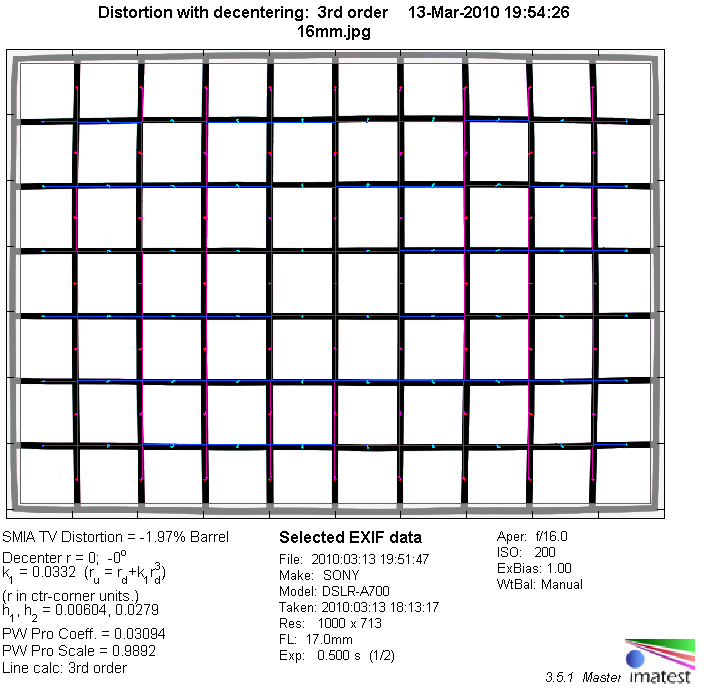|
Zeiss Vario-Sonnar T* 16-35mm f/2.8 ZA SSM ( Sony SAL-1635Z ) - APS-C Review / Lab Test Report - Analysis |
|
Lens Reviews -
Sony Alpha/NEX (APS-C)
|
|
Page 2 of 2

Distortion
The Zeiss produces a medium amount of barrel distortion (~2%) at 16mm. The problem eases
when zooming towards longer focal lengths so there's only a slight degree of barrel distortion left
at 24mm (~0.7%). At 35mm the problem is basically gone (~0.2% pincushion distortion).
|
Move the mouse cursor over the focal length text marks below to observe the respective distortion
|
| 16mm |
24mm |
35mm |

|
The chart above has a real-world size of about 120x80cm.
Vignetting
The Vario-Sonnar is a full format lens so it enjoys the typical sweet spot advantage when used
on APS-C DSLRs. There's only a slight amount of vignetting at max. aperture regardless of the zoom
position and it's not really field relevant anymore from f/4 onwards.

MTF (resolution)
The Zeiss was able to produce pretty impressive resolution figures in the MTF lab but we
expected no less anyway. The lens performs best at 16mm - the center resolution is outstanding
straight from f/2.8. The borders are already very good here but you need to stop down to f/4
to reach excellent results. Typical for APS-C sensors diffraction effects start to reduce
the resolution from f/8 onwards. The Vario-Sonnar is pretty much capable to keeping the performance
in the middle of the zoom range although there's a slight penalty at f/2.8. There's a
more pronounced drop in quality at 35mm - the center performance remains great but the borders
are a bit soft at f/2.8 so it makes sense to stop down to f/5.6 for an extra kick in quality here.
The Zeiss produces some field curvature at 16mm (the focus field is not flat here).
Please note that the MTF results are not directly comparable across the different systems!
Below is a simplified summary of the formal findings. The chart shows line widths per picture height (LW/PH) which can be taken as a measure for sharpness.
If you want to know more about the MTF50 figures you may check out the corresponding Imatest Explanations
Chromatic Aberrations (CAs)
Lateral chromatic aberrations (color shadows at harsh contrast transitions) are
quite well controlled at around ~1.2px at max. aperture and around ~0.8px when stopping
down. This may be noticeable at 100% magnification on screen but it's not really an
issue on prints anymore.

Verdict
The Zeiss Vario-Sonnar T* 16-35mm f/2.8 ZA SSM produced convincing performance figures
in our APS-C-based lab tests. The lens is extremely sharp at 16mm and 24mm although the
quite high field curvature at 16mm could be better. The quality is somewhat lower at 35mm when
using large aperture settings but stopping down resolves this problem.
Lateral CAs, distortions as well as vignetting are well controlled and not overly field
relevant anymore.
The mechanical quality of the lens is very high thanks to a tightly assembled combination of
high quality plastic and metal parts. The SSM AF is both very fast and accurate and definitely
a progress compared to the old screw-driven AF.
The Vario-Sonnar is a pricey lens and it is a bit questionable whether it makes sense on
APS-C DSLRs. In this scope it competes with much cheaper but high quality lenses a la
Zeiss 16-80mm f/3.5-4.5 ZA DT or the Tamron AF 17-50mm f/2.8 SP.
|